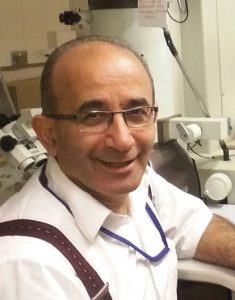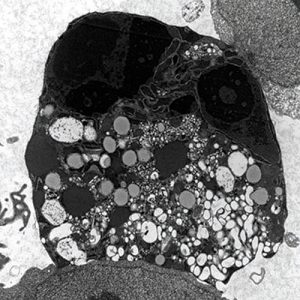 Mones Saadeddin Abu-Asab was born in Jerusalem and grew up in Al-Bireh. He holds a PhD from Ohio University in phylogenetic systematics (a field within biology that reconstructs evolutionary history and studies the patterns of relationships among organisms).
Mones Saadeddin Abu-Asab was born in Jerusalem and grew up in Al-Bireh. He holds a PhD from Ohio University in phylogenetic systematics (a field within biology that reconstructs evolutionary history and studies the patterns of relationships among organisms).
Dr. Abu-Asab has taught at Birzeit and Al-Quds universities (West Bank, Palestine), and worked at the Smithsonian Institution (Washington, DC), Walter Reed Army Institute of Research (Silver Spring, Maryland), and George Washington University’s School of Medicine (Washington, DC). In 1998, he joined the Laboratory of Pathology at the National Cancer Institute in Bethesda, Maryland, and since 2011, he has served as a senior scientist at the National Eye Institute of the National Institutes of Health in Bethesda, Maryland. In his current position, he works on clinical and research projects in ultrastructural pathology, which focuses on the fine structural changes that take place as a result of disease processes.

Dr. Abu-Asab’s record of publication is diverse and includes papers and book chapters on bioinformatics, tumor biology, systematics, virology, traditional medical systems, and global warming. His 2001 publication on global warming prompted a change in the date of the famous Cherry Blossom Festival in Washington, DC, USA, which is now held one week earlier than originally scheduled. Most recently, he is an advocate of the highly innovative method of applying phylogenetic analysis to clinical data of cellular metabolism and proteins in biomedical research. He has published on the topic since 2006, and his analyses have shown that phylogenetic algorithms are a multidimensional tool that can be utilized for diagnosis, disease modeling, genotype profiling and subtyping, and for the discovery of biomarkers in cancer that greatly aid in the prevention and early diagnosis of the disease.
In 2013, he published Avicenna’s Medicine, a book on the scientific interpretation of the traditional Arabic and Islamic medical system, which has since become a major reference in the field of integrative medicine.

